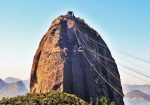Information about Rio de Janeiro
It is one of the major economic centers, cultural and financial resources of the country, and is internationally known for its cultural icons and landscapes, the Sugar Loaf, the statue of Christ the Redeemer (one of the seven wonders of the modern world), the beaches of Copacabana and Ipanema, the Maracanã Stadium, Tijuca National Park (the largest urban forest in the world), the Quinta da Boa Vista, the island of Paqueta, Feasts Years Eve in Copacabana and Carnival celebration.
Represents the second largest GDP in the country and 30th largest in the world, besides being home to two of the most important Brazilian companies Petrobras and Vale do Rio Doce, now privatizada- and major oil companies and telephony, as well as the largest conglomerate of media and communications companies in Latin America. citation needed It is the second largest research and development in Brazil, reaching 17 of national scientific production (data from 2005).
It is known worldwide as the "Marvelous City" (Cidade Maravilhosa), in Portuguese, hosted the 1950 FIFA World Cup, the 2013 Confederations Cup, the World Youth Day 2013, the 2014 FIFA World Cup and will also host the 2016 Olympics.
On January 20, 1502, was achieved Guanabara Bay by Portuguese explorers in an expedition led by Portuguese explorer Gaspar de Lemos, which involved the Italian navigator Amerigo Vespucci. The European presence in the area began soon after. In 1519 when Ferdinand Magellan landed their ships in the bay, French smugglers were already using the bay as a post for smuggling brazilwood. When French naval officer Nicolas Durand de Villegaignon came in 1555 with a fleet of two ships and 600 soldiers and settlers founded the first permanent European settlement in the area. The colony was called France Antarctica. The colonists consisted mainly of French Huguenots and Swiss Calvinists.
The city was founded on March 1, 1565, by the Spanish priest, specifically Tenerife, Padre Anchieta, with the name of San Sebastian River of January. For centuries, the settlement was called San Sebastian, instead of the currently popular second half of its name. The aim of the foundation was to have a base from which could invade the French settlement, which was finally achieved in 1567 and the French were expelled.
A late sixteenth century, Rio was a strategic place in the Atlantic for the transit of ships between Brazil, colonies of Africa and Europe. Fortresses were built and an alliance with nearby native tribes to defend the city was formed. Sugar cane was the first industry in the area. First natives were used, but later African slaves were used for these crafts.
Until early in the seventeenth century, the city was threatened or invaded by pirates and French buccaneers, such as Jean-François Duclerc and René Duguay-Trouin. After 1720, when the Portuguese found gold and diamonds in the neighboring captaincy of Minas Gerais, Rio de Janeiro became much more useful than Salvador as a port for exporting wealth, as this was much further north.






